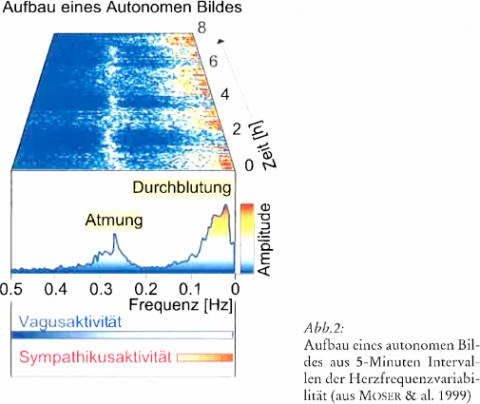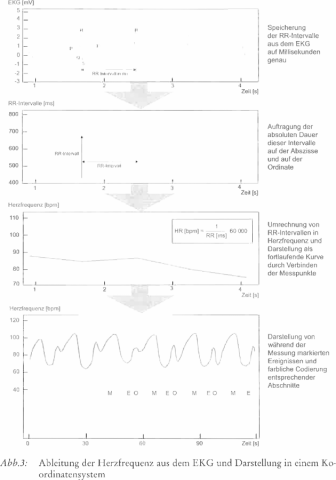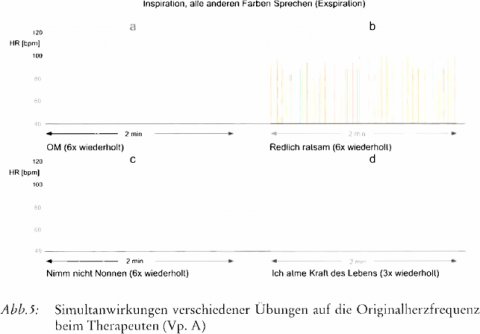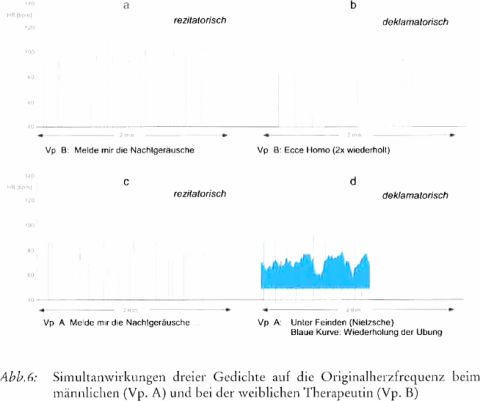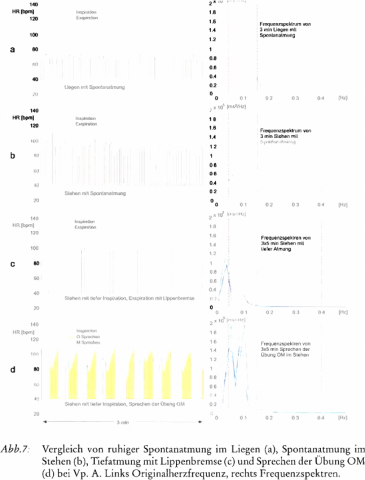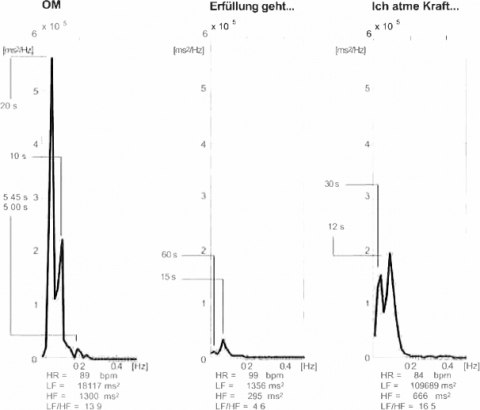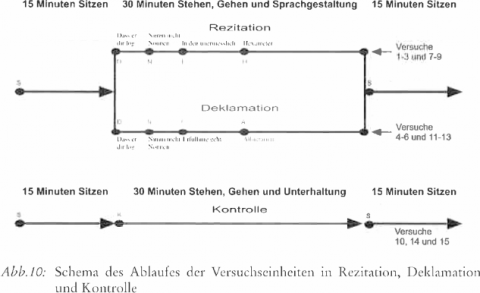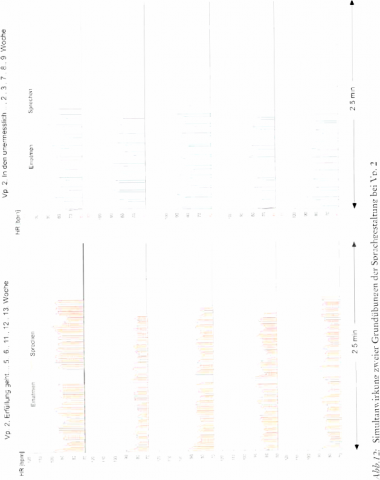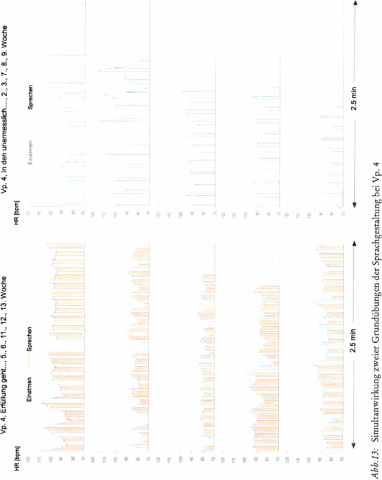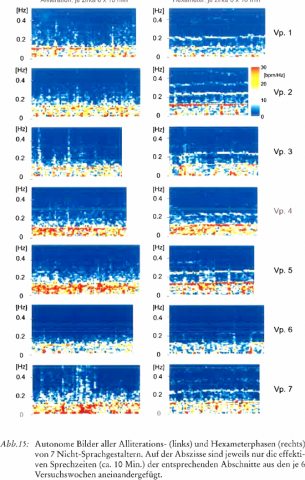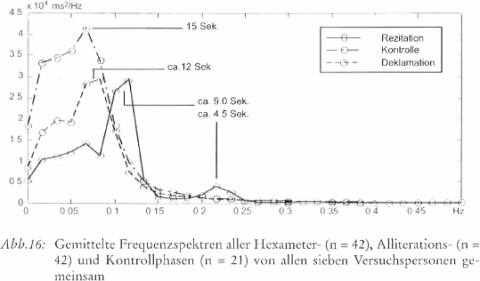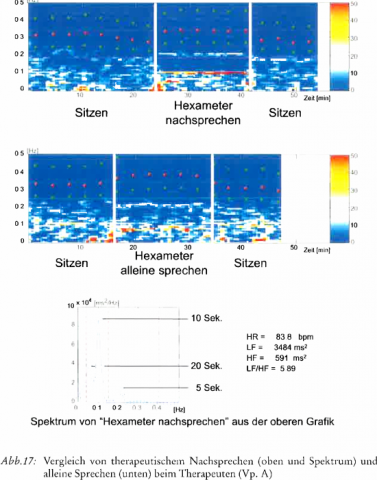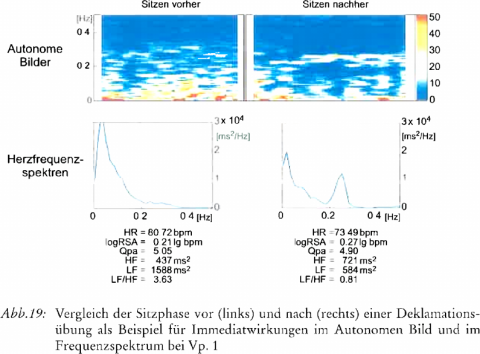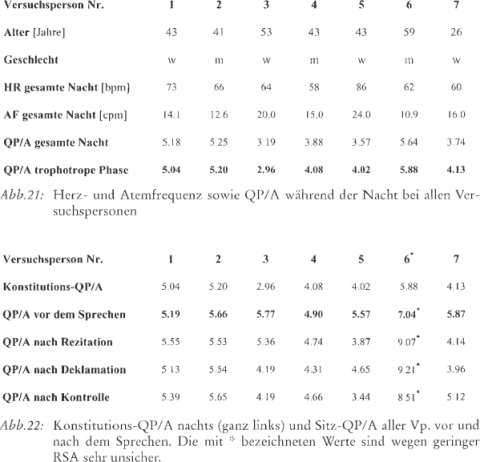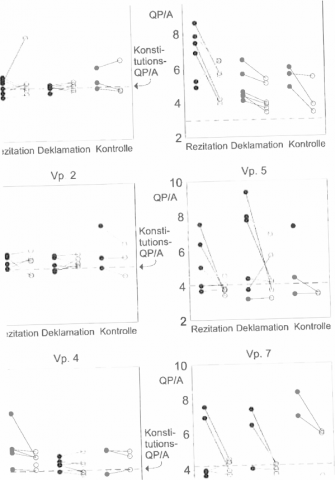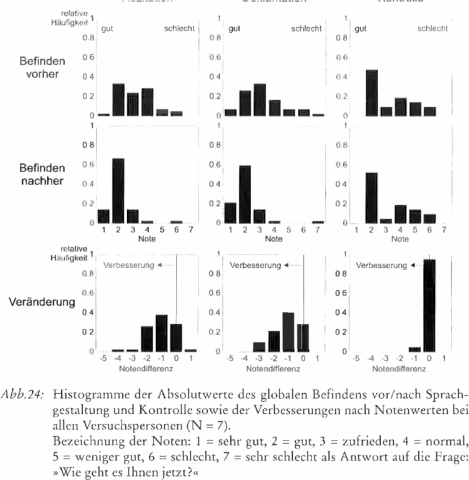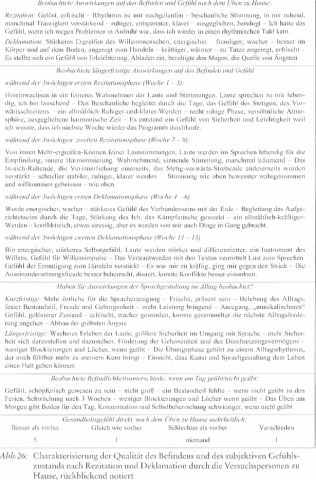Signaturen der Therapeutischen Sprachgestaltung in der Herzfrequenzvariabilität
Export Article Citation as
- Download price : €6
Abstract:
Signatures of therapeutic speech formation in heart rate variability
Background: Anthroposophical Therapeutie Speech uses poems and exercises which typically induce rhythmical breathing. Speaking influences respiration, and thus directly, heart rate variability (I IRV) in particular via respiratory sinus arrhythmia which, together With the slower rhythms of heart rate variability (HRV), may be regarded as an indicator of sympathovagal balance. In ehronomedicine numerous frequency ratios between physiological rhythms, especially in trophotropic phases, have been established. Integer ratios occur frequently and seem to be associated with the optimization of physiological processes. In larger groups the average pulse respiration quotient is about 4:1.
Question: Can systematic effects on HRV, and thus, on autonornic balance, be established through special speech therapy?
Subjects and methods: ln two trained therapists and 7 untrained subjects the influence of different speech exercises and texts on HRV was investigated. With untraincd subjects a total of 105 one-hour sessions, divided into speech and control exercises‚ was performed. The overall well-being and quality of well-being were assessed with questionnaires. Control evaluations were made in the same setting.
Results: As a simultancous effect during speech exercises and texts typical intra- and inter-individually reproducible patterns in heart rate variability were observed. Reciting poems with a hexameter metric generates 2 oscillations with a 2:1-frequency ratio in the HRV-spectrum. As irnmediate effects there was a significant drop in heart rate after speech sessions as well as a strengthcning of vagus related HRV parameters especially after hexameter cxcrcises. In comparison to control sessions the subjects felt significantly better, too. The different metric and poetic character of the texts was rcflected clearly in the results.
References
- BAVASTRO, P. & KÜMMELL, H. C. (Hrsg.) (1999): Das Herz des Menschen. Verlag Freies Geistesleben, Stuttgart
- BETTERMANN, H., ENGELKE, P., VAN LEEUWEN, P. & HECKMANN, Ch. (1996): Die Bestimmung der Atemfrequenz aus der respiratorischen Sinusarrhythmie. Biomedizinische Technik 41 ('l '1): 319-323
- BETTERMANN, H., AMPONSAH, D., CYSARZ, D. & VAN LEEUWEN, P. (1999): Musical rhythms in heart period dynamics: A cross-cultural and interdisciplinary approach to cardiac rhythms. Am. J. Physiol. 277 (Heart Circ. Physiol. 46): H1762-H1770
- BETTERMANN, H., VON BONIN, D., FRÜHWIRTH, M., CYSARZ, D., & MOSER, M. (2002): Effects of speech therapy With poetry on heart rate rhythmicity and cardiorespiratory coordination. International journal of Cardiology 84: 77-88.
- VON BONIN, D., FRÜHWIRTH, M., HEUSSER, P. & MOSER, M. (2001): Wirkungen der Therapeutischen Sprachgestaltung auf Herzfrequenz-Variabilität und Befinden. Forschcnde Komplementärmedizin 8 (3):144-160
- VON BONIN, D., GIGER, A., STÖCKLIN, C., FRUHWIRTH, M. & MOSER, M. (1999): Rhythmologische Untersuchungen zur Sprachtherapie. In: Heusser, P. (Hrsg.): Akademische Forschung in der anthroposophischen Medizin. Verlag Peter Lang, Bern
- DENJEAN, B. & VON BONIN, D. (2000): Therapeutische Sprachgestaltung. Urachhaus Verlag, Stuttgart
- HECKMANN, Ch. (2001): Zur Frage der klinischen Bedeutung des Puls-Atem-Quotienten (QP/A). Der Merkurstab 54 (1): 13-24
- HILDEBRANDT, G. (1977): zit. nach RHEINGANS (1983)
- HILDEBRANDT, G. (1999a): Das Zentrum des rhythmisehen Systems. In: Heusser, P (Hrsg.): Akadef mische Forschung in de1 anthroposophischcn Medizin. Verlag Peter Lang, Bern
- HILDEBRANDT, G. (1999b): Physiologisehe Grundlagen der Hygiogenese. In: Heusser, P. (Hrsg.): Akademische Forschung in der antlu‘opo30phischen Medizin. Verlag Peter Lang, Bern
- HILDEBRANDT, G. & DAUMANN, F.-J. (1965): Die Koordination von Puls und Atemrhythmus bei Arbeit. Int. Z. angew. Physiol. Einschl. Arbeitsphysiologie 21: 27-48
- HILDEBRANDT, G., MOOG, R. & RASCHKE, F. (1987): Chronobiology and Chron<r medicine. Basic Research and Applications. Verlag Peter Lang, Bern
- HILDEBRANDT, G., Mosert, M. & LEHOFER, M. (1998): Chronobiologie und Chronomedizin. Hippokrates Verlag, Stuttgart
- HRUSHESKY, W. J., FADER, D., SCHMITT, O. & GILBERTSEN, V. (1984): The respiratory sinus arrhythmia: A measure of cardiac age. Science 224 (4652): 1001-4
- KÜMMELI, H., BETTERMANN, H. (1996): Ergebnisse rhytlnnologiseher Untersuchungen von Cardiodoron® an Gesunden. Der Merkurstab 49 (5): 361-371
- KUX, W. (1970): Erinnerungen an Rudolf Steiner. Das Goetheanum 19.4.10: 68-69
- MATTHIOIIUS, H., THIEMANN, H.-M. & HILDEBRANDT, G. (1995): Wandlungen der rhythmischen l'1unktionsordnung von Puls und Atmung im Schulalter. Der Merkurstab 48 (4): 297-312
- MOSER, M., LEHOFER, M., SEDMINEK, A., Lux, M., ZAPOTOCZKY, H. G., KENNER, T. & NOORDERGRAAF, M. (1994): Heart Rate Variability as a prognostic tool in Cardiology. Circulation 90: 1078-1082
- MOSER, M., FRÜHWIRTH, M., VON BONIN, D., CYSARZ, D., PENTF.R, R., HECKMANN, Ch. & HIL1)EBRANDT, G. (1999): Das autonome Bild als Methode zur Darsteb lung der Rhythmen des menschlichen Herzschlages. In: lleusser, P. (Hrsg.): Akademische Forschung in der anthroposophisehen Medizin. Verlag Peter Lang, Bern
- MOSER, M., LEHOIJER, M., HILDEBRANDT, G., VOICA, M., EGNER‚ S. & KENNER, T. (1995): Phase and frequency coordination of cardiac and respiratory function. Biological Rhythm Research 26: 100-111
- MOSER, M., LEHOFER, M., HOEHN-SARIC, R., MCLEOD, D., HILDEBRANDT, G., DRNOVSEK, B., EGNER, S., LIEBMANN, P. & ZAPOTOCZRY, ll. G. (1998): Increased heatt rate in depressed subjects in spite of unchanged autonomic balance? J. Affective Disorders 48: 115-124.
- RASCHKE, F. (1981): Die Koppelung zwischen Herzschlag und Atmung beim Men schen. Dissertation. Marburg
- ROHEN, J.-W (1994): Funktionelle Anatomie des Menschen. Schattauer Verlag, Stuttgart, New York
- ROHEN, J.-W., LÜTJPZN-DRECOLL, E. (1996): Funktionelle Histologie. Schattauet Verlag, Stuttgart, New York
- RHEINGANS, H. (1983): Vergleichende Untersuchung über die Wirkung einer aktiv trainierenden und einer künstlerisch-übenan Bewegungsbehandlung bei der kardiologischen Rehabilitation, S. 60. Dissertation. Marburg
- SCHMIDT, R.-F., THEWS, G., LANG, F. (Hrsg.) (2000): Physiologie des Menschen. Springer Verlag, Berlin, Heidelberg, New York
- SIMROCK, K. (Übers.): Götterlieder der älteren Edda. Philip Reclam jun., Nr. 781, Stuttgart
- STEINER, R. (1943): Das Miterleben des Jahreslaufes in vier kosmischen Imaginationen (GA 229), 5. Vortrag. Rudolf Steiner Verlag, Dornach, 8. Auflage 1999
- STEINER, R. (1966): Der unsichtbare Mensch in uns (GA 221), Vortrag vom 11.2.1923. Rudolf Steiner Verlag, Dornach, 3. Auflage 1998
- STEINER, R. (1920): Geisteswissenschaft und Medizin (GA 312), 2. Vortrag. Rudolf Steiner Verlag, Dornach
- STEINER, R. (1955): Methodik und Wesen der Sprachgestaltung (GA 280). Rudolf Steiner Verlag, Dornach, 4. Auflage 1983
- STEINER, R. (1965): Physiologiseh-Therapeutisches auf Grundlage der Geisteswissensehaft (GA 314), S. 120-121. Rudolf Steiner Verlag, Dornach, 3. Auflage 1989
- STEINER, R. (1926): Sprachgestaltung und dramatische Kunst (GA 282). Rudolf Steiner Verlag, Dornach, 4. Auflage 1981
- STEINER, R. (1917): Von Seelenrätseln (GA 21). Rudolf Steiner Verlag, Dornach , 5. Auflage 1983
- STEINER, R. (1928): Die Kunst der Rezitation und Deklamation (GA 281). Rudolf Steiner Verlag, Dornach, 3. Auflage 1987
- TASK FORCE OF THE EUROPEAN SOCIETY OF CARDIOLOGY AND THE NORTH AMERICAN SOCIETY OF PACING AND ELECTROPHYSIOLOGY (1996): Heart Rate Variability. Standards of measurement, physiological interpretation and clinical use. Circulation 93: 1043-65
- TREICHLER, M. (1995): Zur aktuellen Situation der Kunsttherapien. Der Merkurstab 48 (4): 346-351
- WECKENMANN‚ M. (1995): Pilotstudie über die Anamnesefragen Rudolf Steiners, 3.Teil. Der Merkurstab 48 (3): 236-250
- WECKENMANN, M. (1996): Wie kann eine medizinische Diagnose nach anthroposophischen Gesichtspunkten zustande kommen? Der Merkurstab 49 (3): 207-213
- WECKENMANN, M. & SCHREIBER, K. (1982): Die Beziehung des Pulsatemquotienten zu Alter, Geschlecht und Konstitution bei internistischen Patienten. Der Krankenhausarzt 552515-522



